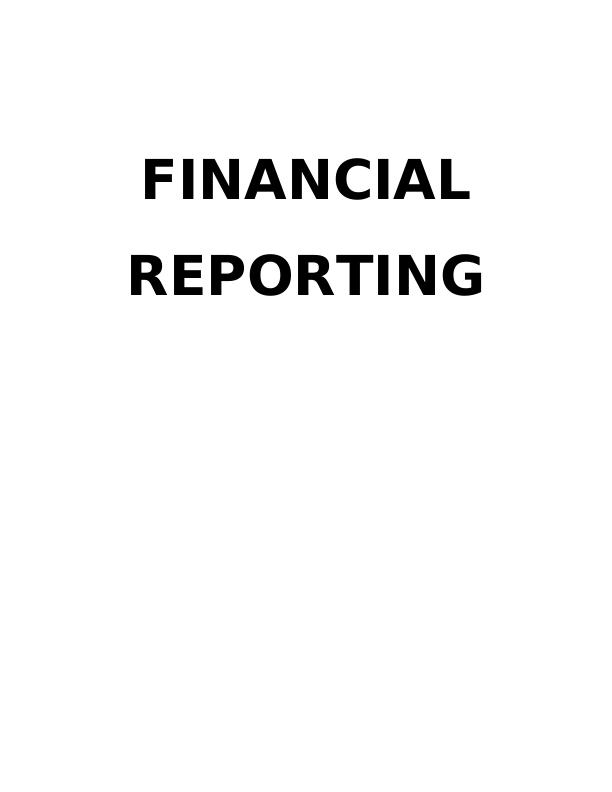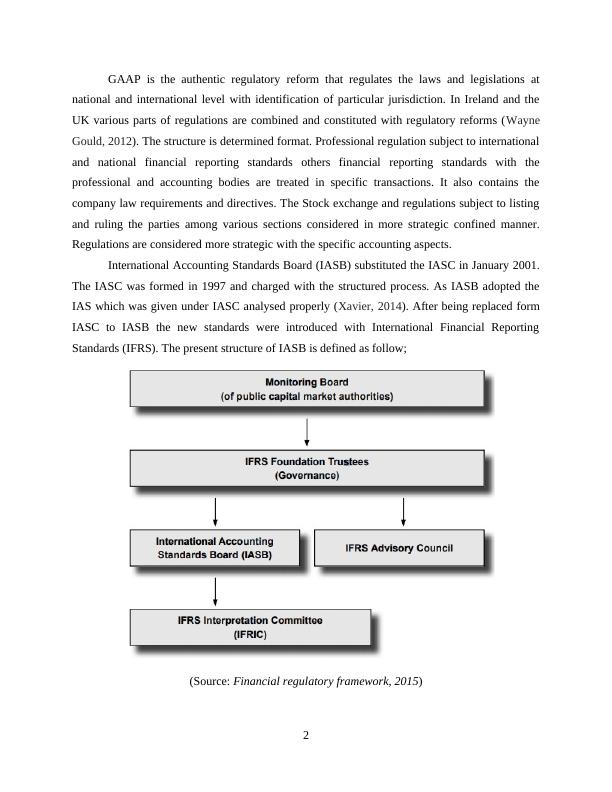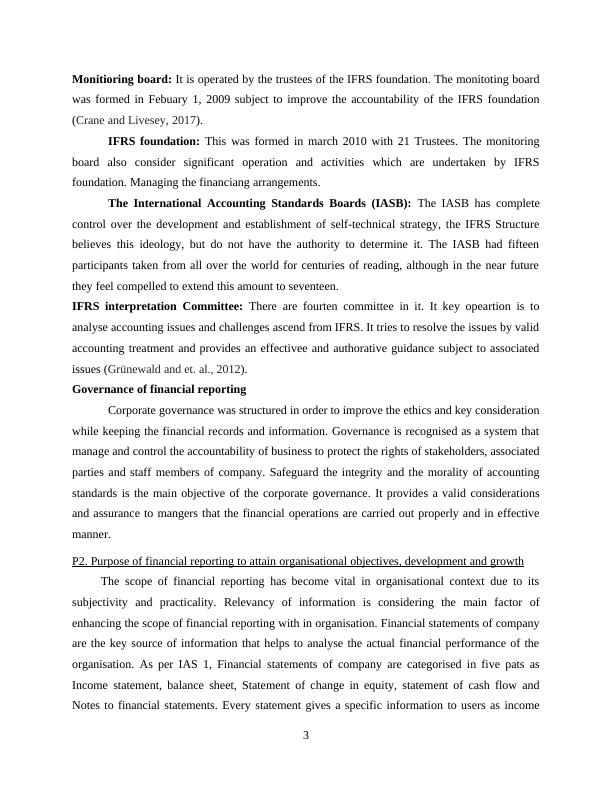P3 Interpret profit and loss, Cash flow and Balance statements
24 Pages8273 Words46 Views
Added on 2021-02-19
P3 Interpret profit and loss, Cash flow and Balance statements
Added on 2021-02-19
ShareRelated Documents
FINANCIAL
REPORTING
REPORTING

Contents
Contents...........................................................................................................................................2
INTRODUCTION...........................................................................................................................1
TASK 1............................................................................................................................................1
P1 Context of financial reporting including regulatory framework............................................1
P2. Purpose of financial reporting to attain organisational objectives, development and growth
.....................................................................................................................................................3
M1 Evaluation of benefits given to stakeholders........................................................................5
TASK 2............................................................................................................................................6
P3 Interpret profit and loss, Cash flow and Balance statements..................................................6
P4 Financial ratios for organisational performance and investment.........................................10
M2 Interpretation of financial results and ratios of M&S.........................................................12
TASK 3..........................................................................................................................................14
P5 Benefits of International Accounting Standards and International financial reporting
standards....................................................................................................................................14
P6 Assessment of models of financial reporting and Auditing..............................................17
TASK 4..........................................................................................................................................18
P7 Importance and differences of financial reporting across various countries........................18
CONCLUSION..............................................................................................................................19
REFERENCES..............................................................................................................................21
Contents...........................................................................................................................................2
INTRODUCTION...........................................................................................................................1
TASK 1............................................................................................................................................1
P1 Context of financial reporting including regulatory framework............................................1
P2. Purpose of financial reporting to attain organisational objectives, development and growth
.....................................................................................................................................................3
M1 Evaluation of benefits given to stakeholders........................................................................5
TASK 2............................................................................................................................................6
P3 Interpret profit and loss, Cash flow and Balance statements..................................................6
P4 Financial ratios for organisational performance and investment.........................................10
M2 Interpretation of financial results and ratios of M&S.........................................................12
TASK 3..........................................................................................................................................14
P5 Benefits of International Accounting Standards and International financial reporting
standards....................................................................................................................................14
P6 Assessment of models of financial reporting and Auditing..............................................17
TASK 4..........................................................................................................................................18
P7 Importance and differences of financial reporting across various countries........................18
CONCLUSION..............................................................................................................................19
REFERENCES..............................................................................................................................21

INTRODUCTION
Financial reporting considered as a method of executing information of financial evets,
transactions, strategies and plans to managers, executives and stakeholders of organisation. This
report annotates the concept of financial reporting with purpose and objectivity (Ayila, 2015).
This report is produced to line manager of Ernst & Young to define the background and concept
of international financial reporting. Company provides professional services as accounting,
auditing services to manufacturers, engineering and construction companies. Assessment of the
regulatory and conceptual framework of financial reporting and accounting is analysed to
evaluate the purpose and principle of business. Reason of financial reporting requirements and
characteristics of reliable financial information explain in a very terse manner. Meaning of
stakeholder of a company with their interest in organisational goals and how they get benefited
by accomplishment of organisational goals elaborated with practicality. Essentiality of financial
reporting defined in terms of fulfilment of business goals and growth perspective in this report.
With the help of understanding of IAS 1, users would be able to construct the financial
statements for a company. Interpretation of financial statements of the Marks and Spencer. The
diversity between the IAS and financial reporting standard analysed defined properly. Benefits of
IFRS in order to maintain ethicalness in the financial reporting explained in this report properly.
Degree of compliance is measured with IFRS by companies across the countries. The impact of
international financial and accounting standards upon national accounting standards with
appropriate examples are evaluated in more strategic manner.
TASK 1
P1 Context of financial reporting including regulatory framework
Sound financial coverage is a crucial component of the resilience of a corporation. It’s really is
vital to companies as well as the shareholders to be able to believe and comprehend the
economic situation of a company (Szychta and de la Rosa, 2012). False or outdated financial
statements leave a business vulnerable to failures and missed opportunities. The findings for
companies and their shareholders and borrowers could be devastating. When financial conditions
shift and enterprise difficulties and possibilities emerge, most significant instrument is prompt
and precise financial information.
Regulatory framework
1
Financial reporting considered as a method of executing information of financial evets,
transactions, strategies and plans to managers, executives and stakeholders of organisation. This
report annotates the concept of financial reporting with purpose and objectivity (Ayila, 2015).
This report is produced to line manager of Ernst & Young to define the background and concept
of international financial reporting. Company provides professional services as accounting,
auditing services to manufacturers, engineering and construction companies. Assessment of the
regulatory and conceptual framework of financial reporting and accounting is analysed to
evaluate the purpose and principle of business. Reason of financial reporting requirements and
characteristics of reliable financial information explain in a very terse manner. Meaning of
stakeholder of a company with their interest in organisational goals and how they get benefited
by accomplishment of organisational goals elaborated with practicality. Essentiality of financial
reporting defined in terms of fulfilment of business goals and growth perspective in this report.
With the help of understanding of IAS 1, users would be able to construct the financial
statements for a company. Interpretation of financial statements of the Marks and Spencer. The
diversity between the IAS and financial reporting standard analysed defined properly. Benefits of
IFRS in order to maintain ethicalness in the financial reporting explained in this report properly.
Degree of compliance is measured with IFRS by companies across the countries. The impact of
international financial and accounting standards upon national accounting standards with
appropriate examples are evaluated in more strategic manner.
TASK 1
P1 Context of financial reporting including regulatory framework
Sound financial coverage is a crucial component of the resilience of a corporation. It’s really is
vital to companies as well as the shareholders to be able to believe and comprehend the
economic situation of a company (Szychta and de la Rosa, 2012). False or outdated financial
statements leave a business vulnerable to failures and missed opportunities. The findings for
companies and their shareholders and borrowers could be devastating. When financial conditions
shift and enterprise difficulties and possibilities emerge, most significant instrument is prompt
and precise financial information.
Regulatory framework
1

GAAP is the authentic regulatory reform that regulates the laws and legislations at
national and international level with identification of particular jurisdiction. In Ireland and the
UK various parts of regulations are combined and constituted with regulatory reforms (Wayne
Gould, 2012). The structure is determined format. Professional regulation subject to international
and national financial reporting standards others financial reporting standards with the
professional and accounting bodies are treated in specific transactions. It also contains the
company law requirements and directives. The Stock exchange and regulations subject to listing
and ruling the parties among various sections considered in more strategic confined manner.
Regulations are considered more strategic with the specific accounting aspects.
International Accounting Standards Board (IASB) substituted the IASC in January 2001.
The IASC was formed in 1997 and charged with the structured process. As IASB adopted the
IAS which was given under IASC analysed properly (Xavier, 2014). After being replaced form
IASC to IASB the new standards were introduced with International Financial Reporting
Standards (IFRS). The present structure of IASB is defined as follow;
(Source: Financial regulatory framework, 2015)
2
national and international level with identification of particular jurisdiction. In Ireland and the
UK various parts of regulations are combined and constituted with regulatory reforms (Wayne
Gould, 2012). The structure is determined format. Professional regulation subject to international
and national financial reporting standards others financial reporting standards with the
professional and accounting bodies are treated in specific transactions. It also contains the
company law requirements and directives. The Stock exchange and regulations subject to listing
and ruling the parties among various sections considered in more strategic confined manner.
Regulations are considered more strategic with the specific accounting aspects.
International Accounting Standards Board (IASB) substituted the IASC in January 2001.
The IASC was formed in 1997 and charged with the structured process. As IASB adopted the
IAS which was given under IASC analysed properly (Xavier, 2014). After being replaced form
IASC to IASB the new standards were introduced with International Financial Reporting
Standards (IFRS). The present structure of IASB is defined as follow;
(Source: Financial regulatory framework, 2015)
2

Monitioring board: It is operated by the trustees of the IFRS foundation. The monitoting board
was formed in Febuary 1, 2009 subject to improve the accountability of the IFRS foundation
(Crane and Livesey, 2017).
IFRS foundation: This was formed in march 2010 with 21 Trustees. The monitoring
board also consider significant operation and activities which are undertaken by IFRS
foundation. Managing the financiang arrangements.
The International Accounting Standards Boards (IASB): The IASB has complete
control over the development and establishment of self-technical strategy, the IFRS Structure
believes this ideology, but do not have the authority to determine it. The IASB had fifteen
participants taken from all over the world for centuries of reading, although in the near future
they feel compelled to extend this amount to seventeen.
IFRS interpretation Committee: There are fourten committee in it. It key opeartion is to
analyse accounting issues and challenges ascend from IFRS. It tries to resolve the issues by valid
accounting treatment and provides an effectivee and authorative guidance subject to associated
issues (Grünewald and et. al., 2012).
Governance of financial reporting
Corporate governance was structured in order to improve the ethics and key consideration
while keeping the financial records and information. Governance is recognised as a system that
manage and control the accountability of business to protect the rights of stakeholders, associated
parties and staff members of company. Safeguard the integrity and the morality of accounting
standards is the main objective of the corporate governance. It provides a valid considerations
and assurance to mangers that the financial operations are carried out properly and in effective
manner.
P2. Purpose of financial reporting to attain organisational objectives, development and growth
The scope of financial reporting has become vital in organisational context due to its
subjectivity and practicality. Relevancy of information is considering the main factor of
enhancing the scope of financial reporting with in organisation. Financial statements of company
are the key source of information that helps to analyse the actual financial performance of the
organisation. As per IAS 1, Financial statements of company are categorised in five pats as
Income statement, balance sheet, Statement of change in equity, statement of cash flow and
Notes to financial statements. Every statement gives a specific information to users as income
3
was formed in Febuary 1, 2009 subject to improve the accountability of the IFRS foundation
(Crane and Livesey, 2017).
IFRS foundation: This was formed in march 2010 with 21 Trustees. The monitoring
board also consider significant operation and activities which are undertaken by IFRS
foundation. Managing the financiang arrangements.
The International Accounting Standards Boards (IASB): The IASB has complete
control over the development and establishment of self-technical strategy, the IFRS Structure
believes this ideology, but do not have the authority to determine it. The IASB had fifteen
participants taken from all over the world for centuries of reading, although in the near future
they feel compelled to extend this amount to seventeen.
IFRS interpretation Committee: There are fourten committee in it. It key opeartion is to
analyse accounting issues and challenges ascend from IFRS. It tries to resolve the issues by valid
accounting treatment and provides an effectivee and authorative guidance subject to associated
issues (Grünewald and et. al., 2012).
Governance of financial reporting
Corporate governance was structured in order to improve the ethics and key consideration
while keeping the financial records and information. Governance is recognised as a system that
manage and control the accountability of business to protect the rights of stakeholders, associated
parties and staff members of company. Safeguard the integrity and the morality of accounting
standards is the main objective of the corporate governance. It provides a valid considerations
and assurance to mangers that the financial operations are carried out properly and in effective
manner.
P2. Purpose of financial reporting to attain organisational objectives, development and growth
The scope of financial reporting has become vital in organisational context due to its
subjectivity and practicality. Relevancy of information is considering the main factor of
enhancing the scope of financial reporting with in organisation. Financial statements of company
are the key source of information that helps to analyse the actual financial performance of the
organisation. As per IAS 1, Financial statements of company are categorised in five pats as
Income statement, balance sheet, Statement of change in equity, statement of cash flow and
Notes to financial statements. Every statement gives a specific information to users as income
3

statements states that how much profit or loss earned by company subject to a particular
accounting year, balance sheet states the amount of assets and liabilities retained by organisation
in a particular period, cash flow statements presents the information related to flow of cash and
cash equilanets in order to run business operations, Change in equity statement presents the
information related to overall equity and reserves retained by company and variation in the share
capital, Notes to financial accounts contains the subjective information of each elements
recorded in income statement and balance sheet of company (Deng, Kang and Low, 2013).
Subjectivity and purpose become vast with the increasing scope of financial reporting. The key
purpose of financial reporting is defined as follows:
Strategic formulation: Companies formulate plans, budgets and strategies for sustainable
business operation. Building a sustainable business structure remains key objective of business.
Optimum use of financial resources is the key solution to attain the financial goals. Financial
reporting helps the entity to analyse the strength and capacity whether the sustainable business
structure can be formed. For this purpose, team of accountants and executives put their efforts to
track the financial transactions and events to attain the business objectives in best possible
manner. Organisation’s revenue and profits are monitored on periodic basis and proper reporting
done in order to control excessive or misuse of financial resources. By utilizing information at
required areas helps entity to grab opportunities on the right time that is considered great sign of
growth and development of business.
Correlating objectives of business to stakeholders: Gaining the stakeholder interest and faith
is also considered prime objective of companies. Communicating goals and objectives of
business to suppliers, customers, investors, owners, financial institutions, shareholders is also
main objective of organisation and communicating the valuable information is become the
purpose for organisation. Investors invest their amount in the business and expect higher return
in consideration. If organisation be successful to meet the expectations of stakeholders than the
changes of having less funding facility in future. This maintain the regular flow of financial
resources with in the operation through which organisation be able to accomplish the goals of
business in more effective manner (Hörisch, Freeman and Schaltegger, 2014).
Keeping the employees well informed: Effective employee engagement leads entity
towards targets. For the purpose of connecting employees with the financial position of
organisation, a periodic reporting is carried out by management. This boost up the confidence
4
accounting year, balance sheet states the amount of assets and liabilities retained by organisation
in a particular period, cash flow statements presents the information related to flow of cash and
cash equilanets in order to run business operations, Change in equity statement presents the
information related to overall equity and reserves retained by company and variation in the share
capital, Notes to financial accounts contains the subjective information of each elements
recorded in income statement and balance sheet of company (Deng, Kang and Low, 2013).
Subjectivity and purpose become vast with the increasing scope of financial reporting. The key
purpose of financial reporting is defined as follows:
Strategic formulation: Companies formulate plans, budgets and strategies for sustainable
business operation. Building a sustainable business structure remains key objective of business.
Optimum use of financial resources is the key solution to attain the financial goals. Financial
reporting helps the entity to analyse the strength and capacity whether the sustainable business
structure can be formed. For this purpose, team of accountants and executives put their efforts to
track the financial transactions and events to attain the business objectives in best possible
manner. Organisation’s revenue and profits are monitored on periodic basis and proper reporting
done in order to control excessive or misuse of financial resources. By utilizing information at
required areas helps entity to grab opportunities on the right time that is considered great sign of
growth and development of business.
Correlating objectives of business to stakeholders: Gaining the stakeholder interest and faith
is also considered prime objective of companies. Communicating goals and objectives of
business to suppliers, customers, investors, owners, financial institutions, shareholders is also
main objective of organisation and communicating the valuable information is become the
purpose for organisation. Investors invest their amount in the business and expect higher return
in consideration. If organisation be successful to meet the expectations of stakeholders than the
changes of having less funding facility in future. This maintain the regular flow of financial
resources with in the operation through which organisation be able to accomplish the goals of
business in more effective manner (Hörisch, Freeman and Schaltegger, 2014).
Keeping the employees well informed: Effective employee engagement leads entity
towards targets. For the purpose of connecting employees with the financial position of
organisation, a periodic reporting is carried out by management. This boost up the confidence
4

End of preview
Want to access all the pages? Upload your documents or become a member.
Related Documents
International Financial Reportinglg...
|17
|4122
|28
Financial Reporting: Assignmentlg...
|18
|4797
|439
International Financial Reporting Solved Assignmentlg...
|16
|4741
|27
Financial Accounting Assignment - “Dixons Carphone”lg...
|15
|4365
|378
International Financial Reporting - IFRS Sample Assignmentlg...
|11
|3650
|64
(Doc) Financial Reporting Sample Assignmentlg...
|14
|4016
|63
